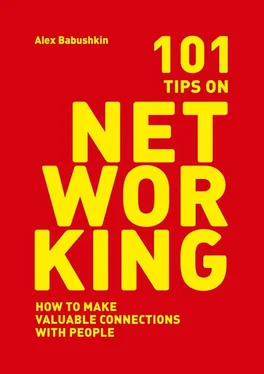101 tips on networking
How to make valuable connections with people
Alex Babushkin
Cover designer Ivan Smagin
Translator Jennifer Sunseri
© Alex Babushkin, 2017
© Ivan Smagin, cover design, 2017
© Jennifer Sunseri, translation, 2017
ISBN 978-5-4485-5773-6
Created with Ridero smart publishing system
Remembering everyone is no easy matter. As a rule, each of us remembers dozens of people, including close friends we see often, or else acquaintances that we’ve talked to recently. If you keep a database of your contacts, you’ll be able to zero in on just who you need a lot faster. Don’t bother with hard-copy spreadsheets. Use Excel, Google Docs, or CRM software. For each person you enter into your database, add keywords you can use for searches later on. Keywords can include: specialty, position, company name, field of activity, city of residence, and so on. Enter new contacts in your database right after you make them. Make sure to update your info on the contact and what each contact has to offer so that it is always relevant.
Make a list of people you want to meet
Set a goal. This is your reference point for networking. Identify three to five people who can help you reach this goal. Expand your network of contacts, starting with getting to know these people.
Get to know networking hubs
Hubs are people with a wide range of active acquaintances. Hubs know a lot of people. These include politicians, journalists, event organizers, PR specialists, and professional networkers. They also include hairdressers, lawyers, headhunters, and successful entrepreneurs. Establish friendly or collaborative relations with these people. This will give you access to their network of contacts. Also, they can help you get in touch with whoever you might need to reach your goal.
Ask friends to introduce you to people from their circle
This is the simplest and most effective way to expand connections. Invite acquaintances over to visit or to a meeting, and suggest they bring along someone you don’t personally know. Think of concentric circles as you expand your network of contacts. The circles grow larger as you make more and more new friends. Turn your friends’ friends into your connections.
Meet VIPs through their circle
If you don’t know how to approach a famous person, then look at his circle and decide who you can easily connect with. This might be a family member, or former and current colleagues, secretaries, friends, classmates. After you’ve developed relations with them, ask them to introduce you to the VIP. Let someone from the celebrity’s circle serve as the bridge between you and him (or her).
Look for novel ways to promote your ideas
Don’t just promote your ideas to the decision-maker. Pay attention to the people around him or her. Sometimes it’s a lot easier getting to know them. Then, you can convey your idea to the decision-maker through them. Often, bosses approve decisions that have been submitted by their subordinates.
Cultivate “budding” connections
Be equally respectful toward who you talk with, regardless of status or position. Don’t just brush someone aside, even if you don’t think he or she is of immediate use to you. You never know – he or she may someday be a successful entrepreneur, and even your boss. All contacts are useful connections.
Write to your former classmates
If you’ve lost contact with your classmates, then most likely you don’t know how successful they are and what they’re up to. Since you lost touch with them, many of your friends from the past have established themselves socially, changed their city of residence, moved into a position of stature in their occupation, or opened their own business. Reconnect with people you used to study with, served with, former colleagues, or your old classmates. Find out what they’re into now, where they work, where they live. Tell them about yourself and your projects. You just might come up with some new opportunities to reach your goals.
Take note of weak connections
People with whom you communicate rarely and only chit-chat with are weak connections. But sometimes those contacts have more to offer than your close friends have. This is because when you hang with the same old group of people, you tend to be a lot like each other, both in terms of your interests and skills. What your close acquaintances know about and have to share is often information that you yourself are already aware of, or have easy access to. As a rule, weak connections have a circle of communications that is different from yours. For you, they represent new opportunities. So don’t forget about your weak connections – cultivate them. Sometimes they might end up being useful.
Build relationships for the future
As a rule, it takes a lot of resources to get to know VIPS and big shots. The most stable relations are built between equals in status. To expand your circle of communications more quickly, start by establishing connections horizontally. Over time, one of the contacts in your network will succeed and move up the ladder.
II. WHAT TO DO BEFORE AN EVENT
Make it a rule to attend at least one event per week
Select events based on your interests, and visit at least one of them each week. Meet at least two people at each event. Then, by the end of the year you will have more than a hundred new acquaintances. If you want more, go to events more often, or increase the number of new acquaintances.
Think about things to talk about
Choose three to five topics that you can easily converse about. You can talk about topics related to your profession, or topics related to your hobbies. Be inquisitive, update your list with new topics.
Prepare a few questions to develop conversations
Think in advance about what you can ask someone when you meet them. For example, ask his opinion about a high-profile event that’s in the news. Or discuss how to improve something. Look at the latest news, scroll through the latest press releases or specialized sites on the Internet. Talk about something that you think is of interest to your conversation partner.
Prepare a mini-presentation about yourself
Work out a succinct, yet interesting way to present yourself. Try to make your self-introduction original and catchy. Add to it an interesting fact about yourself or your company to intrigue your conversation partner.
A director of a diamond disc plant could introduce himself as follows: Greetings! My name is Igor Stavkin, and I run a company that produces the hardest product on earth.
Rehearse the text so that it sounds spontaneous, and so that you don’t forget how it goes. Come up with two or three different versions of this self-introduction. You don’t want to sound like a parrot, repeating the same thing to each newcomer.
Читать дальше












